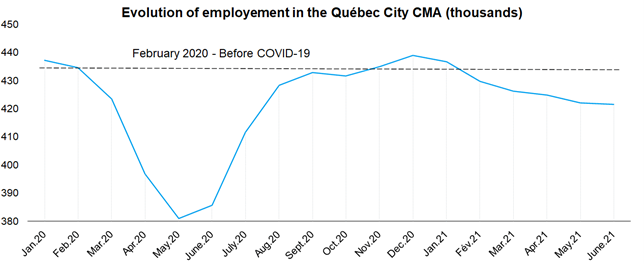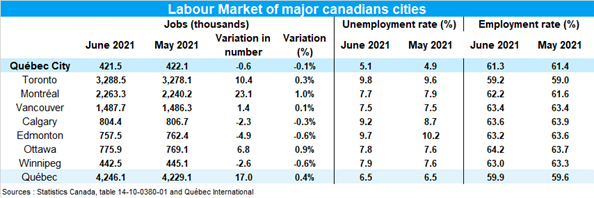Highlights
- Employment in the Québec City census metropolitan area (CMA) varied slightly in June 2021 (-0.1%) compared to the previous month, reaching 421,500 people employed.
- Statistics Canada estimated that there were 444,000 people in the labour force in June. Compared to pre-pandemic results (February 2020), this is a drop of 9,400 people (-2.1%).
- The region had the lowest unemployment rate among all major Canadian CMAs, increasing slightly to 5.1% in June.
- Comparable data for the province of Quebec shows that the number of jobs grew by 17,000 in June 2021. The overall Quebec unemployment rate remained stable at 6.5%.
Charts


Commentary
Statistics Canada’s Labour Force Survey (LFS) data for June shows the labour market conditions during the week of June 13 to 19, 2021. Compared to May, June data reflects the loosening of public health measures on May 28 in the region, including the lifting of the curfew, the limited opening of restaurants, the lifting of interregional travel restrictions, and the loosening of rules regarding indoor venues. Note that the strictness of health measures during the reference week varied from region to region.
Employment varied very little in June
In June 2021, Statistics Canada estimated that there were 421,500 people employed in the Québec City CMA, 600 fewer than in May (-0.1%). The employment level for June was 97% of the level it was just before the pandemic (February 2020). This decrease is the second-most significant drop among major Canadian areas, just ahead of Toronto with 95.1% of its pre-pandemic level.
Stable labour market participation
The number of people in the labour force, i.e. those who were either employed or unemployed, grew slightly by 200 people in June, reaching 444,000 people. However, compared to pre-pandemic results (February 2020), the region registered a drop of 9,400 people (-2.1%). The participation and employment rates remained relatively stable from May to June 2021, reaching 64.6% and 61.3%, respectively. The pandemic and the measures used to fight it seem to have negatively impacted labour market participation in the region. Note that from February 2016 to February 2020, the region’s average monthly participation rate was 68.3%, while the employment rate was 65.6%.
The region maintains the lowest unemployment rate
The unemployment rate increased in June, reaching 5.1%. This is explained by a higher increase in the labour force than in employment. However, the region maintains the lowest unemployment rate among major Canadian CMAs. The unemployment rate is by far lower than the 12% peak observed during the first wave of the pandemic (June 2020) but remains slightly higher than the 4.1% rate from before the COVID-19 crisis (February 2020).
There were 22,500 unemployed people in June in the CMA, i.e. people searching for a job or on temporary layoff. Compared to the previous month, this is a slight increase of 800 people. The region now has 3,800 more unemployed people (+20.3%) than before the pandemic (February 2020). This difference is much lower than in Montréal (+45.9%) and the province of Quebec (+30.9%) for the same period.
Cautionary Note
The available data for the Québec City census metropolitan area (CMA) was given special statistical treatment (three-month moving average) due to the small sample size, which has the effect of mitigating the large fluctuations in the data. Thus, the data collected in April and May influenced the estimations published for the month of June. Please also note that we use comparable data for the province of Quebec and other CMAs in this document. To learn more, please visit: these reminders about moving averages (ISQ, in French only).
Émile Émond
Economist
Québec International




